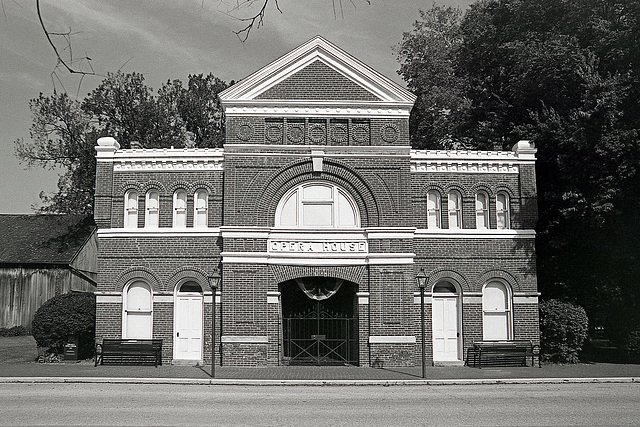1977 Marquee
Brick Wall
Foma Film
Grandma and Grandpa Harrelson
Easter Eggs
Beatles '24
Pastoral
Urn With Moss
Towering
Troop 8605
Thrifty Inn
The Square
Cabin No. 3
As The Sun Sets
Southern Illinois Vista
The Other Side Of The Tracks
Bluffs Of Southern Illinois
70091
Party In Room 149
Plant For A More Beautiful America
Cow Being Towed
Pinhole Front Yard
Cardinal Lane In Pinhole
The Brother
Room With Jugs
Japan Air Lines Postcard
Remains Of The Day
The Helper
The Lava Rocks Of Death
The Mole People
Cinnamon Rolls
Mom And Dad
The Parthenon In Nashville, Tennessee, 1959
Christmas Scene
Once
Socks For Christmas
First, I Have To Bake The Cookies
O Christmas Tree
Christmas Day Sunset 2007
Pumpkin Pies
Happy Easter
Hallowe'en Costume 2023
Lighthouse Landing
Pick Me I'm Single
Hamburger Goulash
See also...
See more...Keywords
Authorizations, license
-
Visible by: Everyone -
All rights reserved
-
61 visits
Thrall's Opera House, New Harmony, Indiana


Known as Harmonists, society members built three towns: Harmony (1804-1814), along the Connoquenessing River in Butler County, Pennsylvania; New Harmony (1814-1824) along the Wabash River in Southern Indiana; and Economy (1824-1906), along the Ohio River in Pennsylvania near Pittsburg. Several hundred members of the religious communal society emigrated with their leader, Johann 'George' Rapp (1757-1847), from Württemberg in the Rhineland, to America between 1803 and 1804. From 1805, until the society's legal dissolution in 1906, the Harmonists amassed considerable wealth in preparation for the coming new heaven and earth.
When originally constructed by the Harmonists, this building served as a communal dormitory for the single men in Father George Rapp's religous society. At that time, it was known as Rooming House 4. After the Harmonists sold New Harmony to Robert Owen in January 1825, it became a community building where lectures, dances and other social activities were held. It was known as the Union Hall in 1859 when it was purchased by the Dramatic Association and became the second largest theatre and ballroom in Indiana.
Eugene S. Thrall bought and improved the building in 1888, adding the front facade, cherry paneling, arches over the windows and door and a curved balcony. Serving primarily as a theatre until 1910, the structure was turned into a gas station in 1914. Double doors were installed in front to accommodate cars, the backstage area served as a grease pit and the balcony was used as auto parts storage. Purchased by the Indiana Department of Natural Resources in 1964, the structure underwent major renovations.
Today, Thrall's Opera House hosts weddings, lectures, musical programs, small conferences and balls. A grand piano sits on the deep stage in the main room where once automobiles sat, waiting to be repaired.
Camera: Minolta XG-SE
Lens: Minolta MD Zoom 28-70mm, f/3.5, @ 28mm
Film: Fuji Film Neopan Acros 100 (expired 06/2015)
Shooting Program: Manual
Aperture: f/11
Shutter Speed: 1/500 of a second
Date: October 8th, 2020, 11.41 a.m.
Location: New Harmony, Indiana, U.S.A.
Developing Chemicals at 68 degrees
Water pre-soak: 5 minutes
Caffenol CM-RS: 11 minutes
Water rinse: 1 minute
Ilford Ilfostop stopbath: 1 minute
Water rinse: 1 minute
Ilford Hypam fixer: 5 minutes
Water rinse: 2 minutes
Kodak Photo-Flo 200: 1 minute
Minolta XG-SE Fuji Acros 100 Fountains 2020 22hf
When originally constructed by the Harmonists, this building served as a communal dormitory for the single men in Father George Rapp's religous society. At that time, it was known as Rooming House 4. After the Harmonists sold New Harmony to Robert Owen in January 1825, it became a community building where lectures, dances and other social activities were held. It was known as the Union Hall in 1859 when it was purchased by the Dramatic Association and became the second largest theatre and ballroom in Indiana.
Eugene S. Thrall bought and improved the building in 1888, adding the front facade, cherry paneling, arches over the windows and door and a curved balcony. Serving primarily as a theatre until 1910, the structure was turned into a gas station in 1914. Double doors were installed in front to accommodate cars, the backstage area served as a grease pit and the balcony was used as auto parts storage. Purchased by the Indiana Department of Natural Resources in 1964, the structure underwent major renovations.
Today, Thrall's Opera House hosts weddings, lectures, musical programs, small conferences and balls. A grand piano sits on the deep stage in the main room where once automobiles sat, waiting to be repaired.
Camera: Minolta XG-SE
Lens: Minolta MD Zoom 28-70mm, f/3.5, @ 28mm
Film: Fuji Film Neopan Acros 100 (expired 06/2015)
Shooting Program: Manual
Aperture: f/11
Shutter Speed: 1/500 of a second
Date: October 8th, 2020, 11.41 a.m.
Location: New Harmony, Indiana, U.S.A.
Developing Chemicals at 68 degrees
Water pre-soak: 5 minutes
Caffenol CM-RS: 11 minutes
Water rinse: 1 minute
Ilford Ilfostop stopbath: 1 minute
Water rinse: 1 minute
Ilford Hypam fixer: 5 minutes
Water rinse: 2 minutes
Kodak Photo-Flo 200: 1 minute
Minolta XG-SE Fuji Acros 100 Fountains 2020 22hf
SV1XV, Albrecht Girle, John FitzGerald and 2 other people have particularly liked this photo
- Keyboard shortcuts:
Jump to top
RSS feed- Latest comments - Subscribe to the comment feeds of this photo
- ipernity © 2007-2024
- Help & Contact
|
Club news
|
About ipernity
|
History |
ipernity Club & Prices |
Guide of good conduct
Donate | Group guidelines | Privacy policy | Terms of use | Statutes | In memoria -
Facebook
Twitter

Sign-in to write a comment.